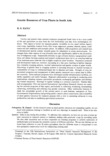Genetic Resources of Crop Plants in South Asia
JIRCAS international symposium series
| ISSN | 13406108 |
|---|---|
| 書誌レコードID(総合目録DB) | AA1100908X |

本文フルテキスト
intlsymp-2_17-18.pdf53.15 KB
Vavilov and several other eminent explorers recognized South Asia to be a true cradle of life and agriculture as seen from the rich biodiversity and also from archeological evidence. This region is known for immense genetic variability in rice, small millets, leguminous crops, vegetables, tropical fruits, fibre crops, sugarcane, grasses, oilseeds, spices, condiments and also medicinal and aromatic plants. In addition, wild progenitors and related taxa of domesticated species contain valuable genes for adaptation to stress environments. Exchanges from other regions of crop diversity have also significantly added to the diversification of indigenous crops. Remarkable diversity in agro-climatic factors, topographical conditions, soil status, farming systems and farmer's preferences have led to an amazing build-up of an enormous gene reservoir that is highly sought by plant breeders. Population pressures and development needs are, however, increasing at a fast pace resulting in habitat degradation, intensive cropping patterns, varietal replacements and genetic erosion of plant wealth. Narrowing of genetic base in cropping systems is alarming because of implied increase in vulnerability of crops to widespread losses due to diseases and pests. Strength of crop improvement programs and management of plant genetic resources vary a great deal in different countries. Some national programs have developed notable infrastructural facilities, scientific capability and useful linkages. Regional collaboration is growing in conducting joint explorations, adopting common quarantine procedures, exchanging germplasm and developing trained manpower. Shortage of regular funding is a common constraint. Besides bilateral arrangements, FAO and several International Agricultural Research Centres are assisting the national programs of this region, particularly in collecting, evaluating, documenting, conserving, networking and utilizing crop genetic resources. Other noteworthy features include the remarkable growth of the private sector in seed business, emergence of Non-Governmental Organizations and growing public concern about conservation and availability of plant genetic resources for research purpose with a view to sustaining advances in crop productivity and also in stabilizing agricultural production.
| 作成者 | R. S. RANA |
|---|---|
| 公開者 | Japan International Research Center for Agricultural Sciences |
| オンライン掲載日 | |
| 号 | 2 |
| 開始ページ | 17 |
| 終了ページ | 18 |
| 言語 | eng |
